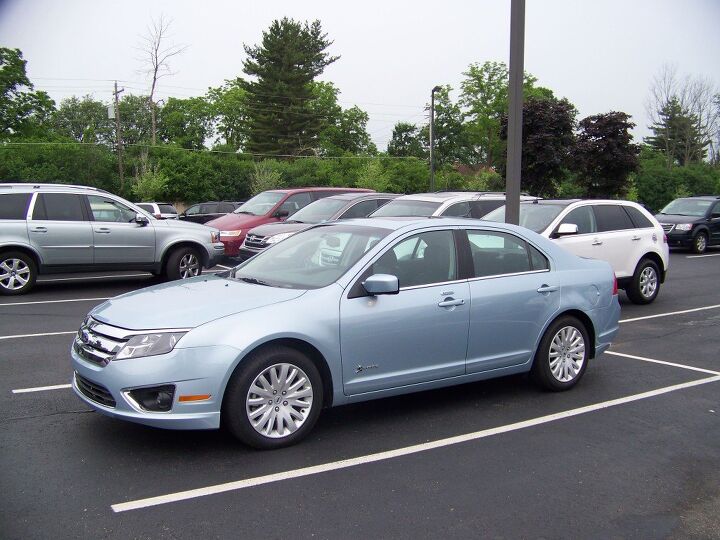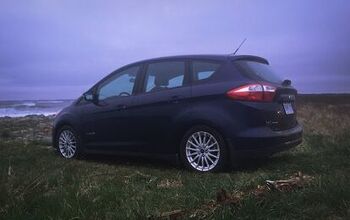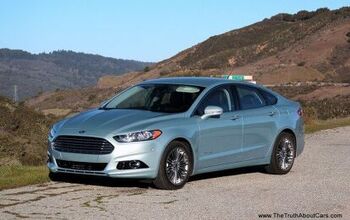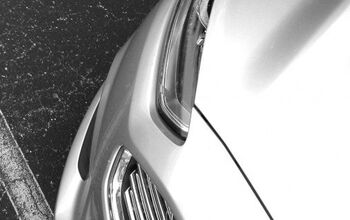Review: Ford Fusion Hybrid 2010
A year ago, with gas prices high and the survival of the domestic auto companies never more in doubt, the media settled on the Ford Fusion Hybrid as the best evidence that Detroit deserved to survive. Roomy, reliable, economical, and fairly affordable, the FFH seemed to tick off all of the boxes. But what about love?
When the Ford Fusion was originally introduced, its exterior appeared crisply handsome. But that was five years ago. A refresh for the 2010 model year cleaned up the tail lights and enlarged the grille, but did nothing to update the thoroughly conventional three-box profile. Consequently, next to more recently designed sedans, the Fusion looks quite staid and dated. And, aside from multi-spoke alloys that do nothing to add visual excitement, the FFH looks just like the regular Fusion. Toyota’s breakout success with the Prius suggests that car buyers want a hybrid’s exterior appearance to reflect the advanced technology contained within. The virtually invisible FFH utterly fails in this regard.
The story remains the same inside the car. With an exception to be covered later, the Ford Fusion Hybrid’s interior styling is plain to a fault. Neither imagination nor attention to detail appears to have played a role. The engineers might well have phoned it in without even involving the designers. But not the human factors engineers—they would never locate the HVAC controls so low on the center stack. Much of the IP is soft to the touch, yet even with the optional leather upholstery the ambiance suggests “fleet.” Oval-shaped hard plastic door pulls resembling those that provide such a poor first impression when entering a Chevy Cobalt, Revell-worthy interior door levers, and geographically disadvantaged HVAC knobs look and feel especially cheap. One nice touch: white stitching on the black leather seats.
The FFH’s conventional styling pays some benefits. The relatively thin, relatively upright A-pillars and generous greenhouse contribute to excellent forward visibility and a familiar driving position. As in the regular Fusion, the unfashionably unarched roof-line permits the insufficiently contoured rear seat cushion to be mounted a comfortable height off the floor. Knee room is generous. But, unlike in the regular Fusion, the rear seatback cannot fold to expand the trunk. Which could use some expanding, as the battery pack takes up its forward third. Want a hatch? Well, Ford offers the same powertrain in the Ford Escape Hybrid. Want a hatch with the handling of a car? Then Ford doesn’t have a hybrid for you.
The FFH’s interior appearance does have two bright spots—literally. Unique to the Hybrid, a pair of reconfigurable LCD displays flank the analog speedometer. Precursors to the MyFord Touch instrumentation that will debut in the 2011 Ford Edge, and then spread to many other Ford models, these displays have graphics that are both vibrant and functional. After mucking about with digital displays for a quarter-century, the auto industry has finally figured out how to make them more than a light show.
In the FFH, the reconfigurable capability is used to provide information about the power flows to and from the various powertrain components in multiple alternative formats. The intent: educate the driver how to drive to maximize efficiency. The theory is sound, but in practice, the FFH’s displays aren’t as helpful as the simpler, less colorful displays in the latest Toyota Prius. Unlike in the Prius, there’s no indication of the point in throttle application at which efficiency falls off. There’s also no indication of the point in brake application at which the conventional brakes jump in to assist the regenerative system. The latter would be especially helpful, since the entire point of a hybrid is to recoup the energy used to accelerate the car when braking the car. Use the conventional brakes, and energy that might recharged the battery pack instead heats up the rotors.
Instead, some of the display options indicate how far you can apply the throttle before the engine kicks in. Interesting information, but with no clear connection to maximizing overall fuel economy. This is still a conventional hybrid with limited battery capacity. No matter how you drive the FFH, you’re not going far before the engine has to kick in to recharge the batteries. Another option: vines that grow leaves when you drive efficiently. Rewarding until the novelty wears off, perhaps, but hardly useful feedback.
One thing Ford offers that Toyota does not: a tach. Perhaps I’m just old school, but the tach provided the most useful feedback for me. Keep the engine speed low, and fuel economy goes up. With the tach it’s also clearer how much power remains in reserve.
So how about the Ford Fusion Hybrid’s fuel economy? In suburban driving I generally managed about 42 MPG, about ten fewer than in the smaller, lighter, less powerful Prius. Drive the FFH aggressively, and this drops into the high 20s. More than in the typical hybrid, you might even want to drive this one aggressively. With no powertrain modes to choose from, there’s no “eco mode” that feels sluggish. Drive the FFH like you would a normal car and it feels like…a normal car. Or at least a normal car with a CVT. Aside from engine noise and the instruments, there’s little indication when the FFH switches from all-electric operation to gasoline power. Dip more than halfway into the throttle, and the FFH actually feels quick. Not as quick as a V6-powered Fusion, but definitely quicker than the conventional four. Unfortunately, when pushed, the FFH’s four-cylinder Atkinson cycle engine turns agricultural. The quantity of power delivery is easily sufficient, but the quality of power delivery leaves much to be desired.
It’s not possible to hold the CVT at a fixed ratio—the power-distributing role of a hybrid’s CVT generally precludes this—but shifting into L does bump engine RPM a couple grand. This is primarily intended for engine braking while descending grades, but it can also serve to keep engine response snappy on a twisty road.
The FFH’s handling is good enough that the front seat’s above-average lateral support comes in handy. The electrically-assisted power steering (EPS) is no more communicative than most such systems, but it is fairly quick and nicely weighted. There’s little lean in hard turns, and body motions are tightly controlled. The taut suspension tuning’s downside: a lumpy, unrefined ride, with sharp vertical reactions even to fairly small bumps. Only driving enthusiasts might appreciate this ride-handling trade-off. Are there enough driving enthusiasts who buy hybrids to justify it? Most car buyers will prefer the smoother, quieter, generally more refined Toyota Camry Hybrid (though the TCH’s powertrain operation and chassis have their own shortcomings).
It’s easy to see why the Ford Fusion Hybrid has attracted so much praise, as it ticks off all the right boxes. With very good fuel economy, passenger room, and reliability at a reasonable price, it’s a rational choice. But permit emotions to intrude, and the FFH falls short. The engine’s character will put off enthusiasts, while the ride quality will put off non-enthusiasts. For enthusiasts and non-enthusiasts alike, the Fusion looks boring and feels rough around the edges. As much as there is to like, there’s too little to love. Ford best not infer from the FFH’s awards that it can rest on its laurels. The next Ford Fusion Hybrid needs to be both more refined and more special.
Ford provided an insured vehicle with a full tank of gas.
Michael Karesh operates TrueDelta.com, a provider of car reliability, real-world fuel economy, and price comparison information.
Michael Karesh lives in West Bloomfield, Michigan, with his wife and three children. In 2003 he received a Ph.D. from the University of Chicago. While in Chicago he worked at the National Opinion Research Center, a leader in the field of survey research. For his doctoral thesis, he spent a year-and-a-half inside an automaker studying how and how well it understood consumers when developing new products. While pursuing the degree he taught consumer behavior and product development at Oakland University. Since 1999, he has contributed auto reviews to Epinions, where he is currently one of two people in charge of the autos section. Since earning the degree he has continued to care for his children (school, gymnastics, tae-kwan-do...) and write reviews for Epinions and, more recently, The Truth About Cars while developing TrueDelta, a vehicle reliability and price comparison site.
More by Michael Karesh
Latest Car Reviews
Read moreLatest Product Reviews
Read moreRecent Comments
- ToolGuy TG likes price reductions.
- ToolGuy I could go for a Mustang with a Subaru powertrain. (Maybe some additional ground clearance.)
- ToolGuy Does Tim Healey care about TTAC? 😉
- ToolGuy I am slashing my food budget by 1%.
- ToolGuy TG grows skeptical about his government protecting him from bad decisions.






































Comments
Join the conversation
This review is similar to how I feel about my Altima Hybrid. As an enthusiast I really like the bit of starch in the suspension and the really effective brakes. The brake pedal feels great, too. I loath mushmobiles - my father's Avalon is an example of what kind of suspension tuning I simply can't own. A few interesting differences, though. The Altima returns a solid 34 MPG; pretty good for rush hour driving and my less than light foot. How smooth is the Fusion on engine restart? The Altima's engine restarts rather roughly if you are stopped and HAL decides the engine needs to run. The small trunk is expected, but the interior finish is rather poor, especially in light of the interior which is really nice for the price range. One interesting thing to note is what was noted under the "Hybrid" plastic cover under the hood. In prominent letters it says "Toyota"!! Another interesting thing was the comparison between my Altima and my mother's MKZ. I drove from work to my folks and then jumped into her MKZ and drove for 8 miles. Such a back-to-back drive was quite enlightening. Structure wise, the Altima felt much more substantial than the MKZ. Funny thing is that while I was rather critical of the MKZ's interior appointments, I always thought it had a good stiff structure. It seems that it does, but the Altima is just a bit better in that regard. Bottom line is that it is a good car, not just a good hybrid. The fact that is looks like a regular car is a plus to me, and I am an outspoken pro-environment guy.
I've always found many of the 4 door sedans rather humdrum IMO. But as to the Ford Fusion Hybrid, have no experience there but DO have some experience with the 2002 Honda Civic Hybrid a friend of mine bought new. It was rather cool for the day in that it looked just like the 4 door EX grade Civic but had the sunroof if I recall right and was the same hybrid drive train as earlier Insight. That said, one thing it DID have was a conventional A/C compressor and I think power steering so at a light in eco mode, you could note the engine was off as no AC, although the fan was kept running - as long as certain conditions were met and your foot was ON the brake and once you released the brake, the engine would restart, the lag was barely perceptible when taking off, otherwise, it hauled 3-4 adults just fine and seemed to have decent acceleration, much like a normal 4 pot Civic would have had, but that was 2002 and I'm sure the technology has improved since then. As for being environmentally friendly, I do that by not living where a car is needed for EVERYTHING one did as I live in the big city and can walk to do most of my daily errands, you know, drug store, grocery store, stuff like that and I CAN walk or take the bus downtown where most of where I shop is located so my aging truck (all I can afford right now) can sit the entire weekend even though I DO drive to and from work 5 days a week.